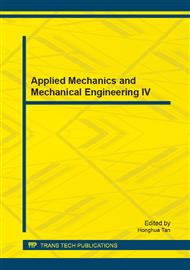[1]
R.J. Wai, K.L. Chuang: Design of backstepping particle-swarm-optimisation control for maglev transportation system. IET Control Theory and Applications Vol. 4 (2010), p.625.
DOI: 10.1049/iet-cta.2008.0270
Google Scholar
[2]
Y.T. Fang, C.Z. Fan: Single neuron network PI control of high reliability linear induction motor for maglev. Journal of Zhejiang University-Science A Vol. 8 (2007), p.408.
DOI: 10.1631/jzus.2007.a0408
Google Scholar
[3]
G. Shen, R. Meisinger, G.W. Shu: Modelling of a high-speed Maglev train with vertical and lateral control, Veh. Syst. Dyn Vol. 46 (2008), p.643.
DOI: 10.1080/00423110802033056
Google Scholar
[4]
S.J. Wu, C.T. Wu, Y.C. Chang: Neural-fuzzy control for a current/voltage-controlled 1/4-vechicle maglev system. IEEE Transactions on Intelligent Transportation Systems Vol. 9 (2008), p.122.
DOI: 10.1109/tits.2007.911353
Google Scholar
[5]
J.D. Yau: Vibration control of maglev vehicles traveling over a flexible guideway. Journal of Sound and Vibration Vol. 321 (2009), p.184.
DOI: 10.1016/j.jsv.2008.09.030
Google Scholar
[6]
C. Nielsen, C. Fulford, M. Maggiore: Path following using transverse feedback linearization: Application to a maglev positioning system. Automatica Vol. 46 (2010), p.585.
DOI: 10.1016/j.automatica.2010.01.009
Google Scholar
[7]
A. Bittar, R.M. Sales: H-2 and H-infinity Control for MagLev Vehicles. IEEE Control Systems Vol. 18 (1998), p.18.
Google Scholar
[8]
S.H. Ju, Y.S. Ho, C.C. Leong: A finite element method for analysis of vibration induced by maglev trains. Journal of Sound and Vibration Vol. 331 (2012), p.3751.
DOI: 10.1016/j.jsv.2012.04.004
Google Scholar
[9]
F.T.K. Au, J.J. Wang, Y.K. Cheung: Impact study of cable-stayed railway bridges with random rail irregularities. Engineering Structures Vol. 24 (2002), p.529.
DOI: 10.1016/s0141-0296(01)00119-5
Google Scholar
[10]
X. Lei, N.A. Noda: Analyses of dynamic response of vehicle and track coupling system with random irregularity of track vertical profile. Journal of Sound and Vibration Vol. 258 (2002), p.147.
DOI: 10.1006/jsvi.2002.5107
Google Scholar


